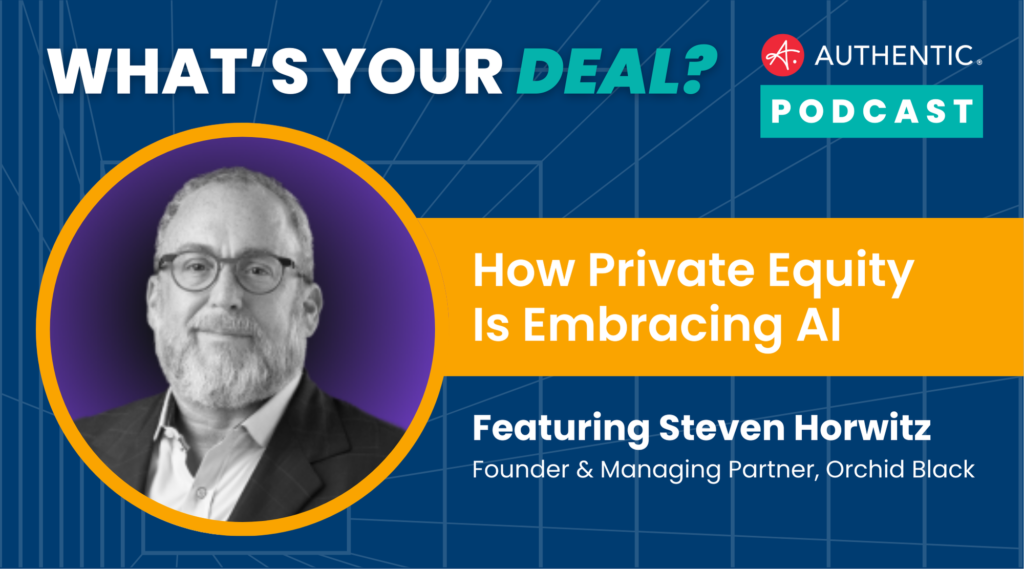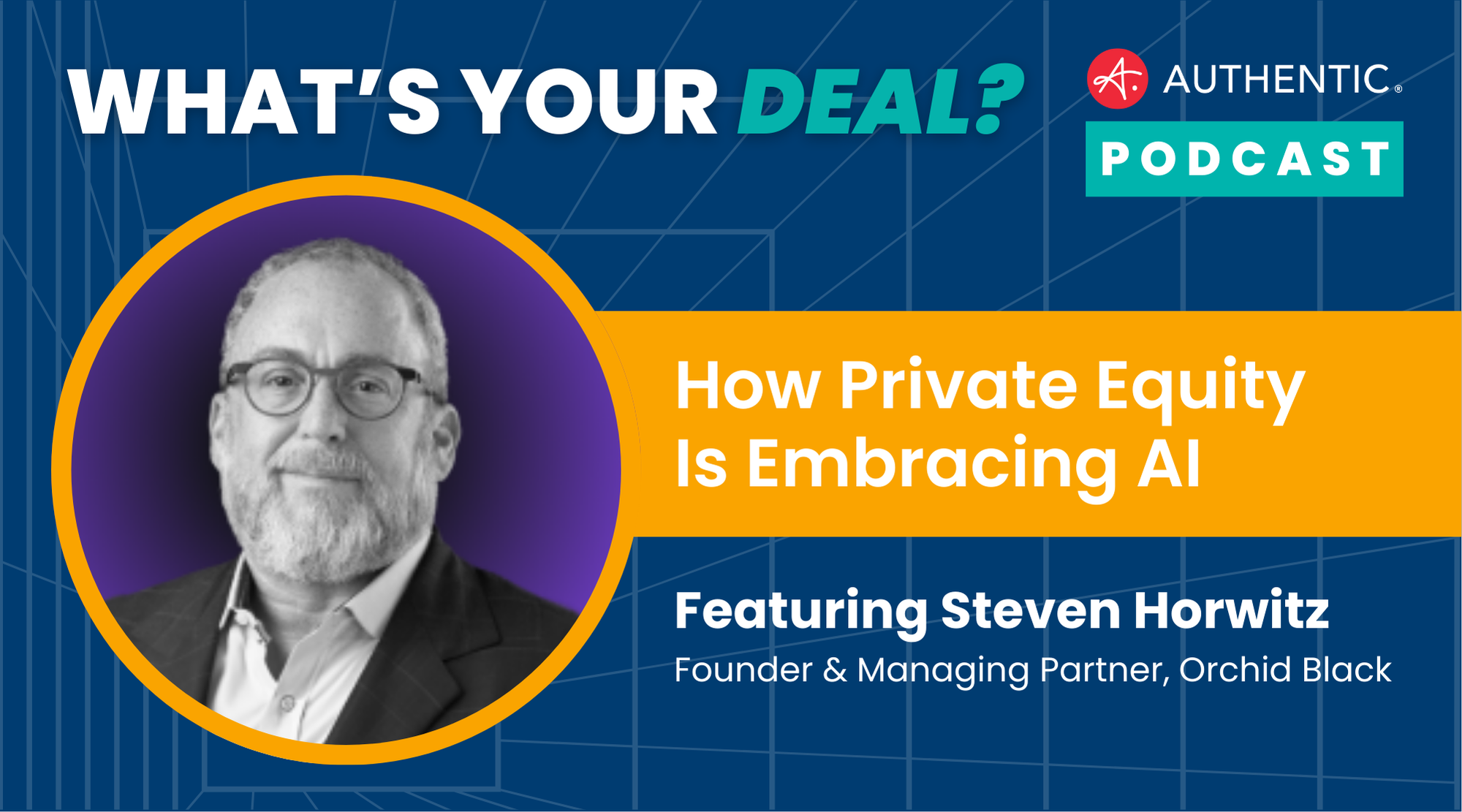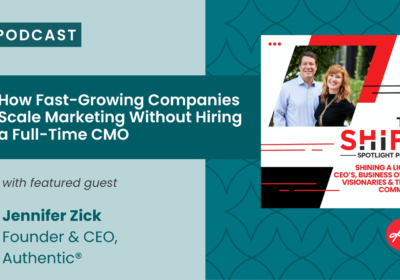
Our inaugural episode of the What’s Your Deal? podcast features Steven Horwitz, Founder and Managing Partner of Orchid Black. Steven is a hands-on, performance-driven leader and strategist with over 30 years of executive leadership and venture capital consulting experience across software and technology-enabled service organizations. His experience spans high growth environments and turnaround situations ranging from early stage, venture-backed software startups through Fortune 100 companies.
Steven sat down for a conversation with our Chief Development Officer, Mark Coronna, to discuss how private equity firms are embracing AI to foster healthy growth and some key considerations for businesses looking to begin using AI. Listen to the podcast and read the transcription below.
Key Takeaways
- To grow sustainably, you must invest wisely and be capital efficient. It’s about driving outcomes rather than just recommending actions.
- The key is to raise capital when you don’t urgently need it. Organic growth and a strong market position attract investment more effectively.
- AI adoption varies widely, with many firms integrating it for business alignment and learning processes. Data quality remains a pivotal factor.
- Ethical governance in AI will become increasingly crucial. Companies must ensure responsible use and data integrity from the outset.
- AI can enhance customer service, streamline operations like processing AP, and improve data management—provided there’s a clear business case and measurable impact.
- Start small, iterate quickly, and focus on measurable outcomes. Adaptability and persistence are key to navigating transformative technologies like AI effectively.
Links & Resources Mentioned
- Orchid Black
- Blackstone Hires Walmart AI Expert to Drive AI Integration Across Portfolio Companies
- On with Kara Swisher
Full Episode Transcription
Introduction
Mark Coronna: Hi everybody, this is Mark Coronna and I’m the Chief Development Officer for Authentic and this is a podcast we call “What’s Your Deal?” It’s a new series that we’re prototyping. The idea here is that for deal makers, and particularly deal makers who are involved in tech companies or companies that use technology for differentiation, we think that there’s a lot of things going on that are worth additional discovery. And my guest today is Steven Horowitz. Steven is a founder and managing partner from a business consultancy called Orchid Black. Steven, I’m going to let you have the floor here to introduce yourself and provide a little perspective on what you bring into this conversation, what you think you’d like to contribute, and then a little bit on Orchid Black, help our listeners understand more about what you’re up to.
Steven Horwitz: Sure Mark, thanks. Nice to be here on your inaugural launch of this podcast. I’m with Orchid Black. We’re a boutique consultancy composed of very experienced operators who’ve been in the tech and tech enabled services sector for 20, 30, 40 years. And having experienced startup world growth up to billion dollar plus, sort of PE backed and publicly traded tech companies, we’ve decided to focus on founders on their journey who are looking to radically look at the value creation opportunities on the path towards some monetization events.
We’ve got a unique approach on how we partner with those founders. Ultimately, our goal is to roll up our sleeves and not just tell you what you should do, but actually help you go do it and go execute it and go drive the right outcomes.
We also focus a portion of our business on supporting the private equity community and that’s both on buy side due diligence and were not your typical due diligence financial big in, we’re more on the go to market product market fit. What are those growth opportunities really around the product or service? Ultimately in some cases, we come in and help optimize their portfolio along with the same outcomes.
Go-To-Market Strategy
Mark Coronna: I think that’s one of the things you and I and our businesses have in common is that we look at the go to market model and the go to market part of any organization’s business as an opportunity.
A lot of what I get involved in with Authentic is similar to you. Someone’s got a growth need, a growth challenge, and that can come from any number of different sources. It can be just a desire to double in size in three or five years, or it can come from a position of flat growth or no growth or stagnation. And there are those companies sometimes you get involved with. They’re slipping away because they don’t actually have an effective go to market model.
I think this is an important topic for you and I to take up because focusing on growth in particular, and I use growth, but I should also say that the word profitable should be in front of the word growth every time I use it. You would agree with that too. Yes, because it’s not growth for growth’s sake. We’re a couple guys, been around a while, enough to know that’s not a formula for success. Right?
Steven Horwitz: We often have to remind folks that to grow, you typically have to invest, which means you’ve got to put the money in and you’ve got to be really capital efficient. It’s critically important to not do science projects because science projects don’t always work out well unless you’ve got a massive balance sheet and most of us don’t.
Mark Coronna: Right. Yeah. There’s an old axiom I heard from someone, which I’ve carried with me, which is that the time to grow is when you can, not when you have to. Because then you can be more thoughtful, more planful. You’ve got capital that you can invest in it. You can probably manage the risks more proactively when the gun is next to your head and you realize, I’ve got growth issues now, not opportunities, but real issues. That’s a whole different environment to try to grow in. .
Steven Horwitz: Absolutely. Along that same notion, Mark, the time to raise capital is not when you desperately need the capital, it’s when you don’t need the capital.
I’ve always, for the past 20 years, I like the theory of being bought, not sold. And not that bringing in a banker and running through a process is not the right thing to do. In some instances it certainly is. But organically, if you’ve got people knocking on your door because you’re doing a good job in the market and your name is out there and you’re winning deals and growing, that’s always a much better position of strength from which to work from.
Strategic Planning & Execution
Mark Coronna: Yeah, I would totally agree with you on that. And so we not only encourage our clients to think about growth in a healthy way, but we also, I think both our organizations help provide them with tools and approaches that are pretty much time tested and based on a lot of expert input to help them do that and do it in a way that’s efficient and effective and will yield a kind of incremental growth that will result in higher valuation.
I think maybe it doesn’t need to be said, Steven, but I think we should say this is, I think you and I are both very firm believers that if you take a five year view of any organization, it’s incremental, profitable revenue streams that drive valuation. I think you can’t shrink your way to greatness.
There’s nothing wrong with being operationally efficient and operationally effective, but at some point, you’re smiling. I know you got thoughts on this.
Steven Horwitz: Well, cutting your way to growth, it’s never worked for me. I’m not saying it hasn’t worked for other people, but in my 40 years of experience with lots of companies, once you start cutting, and if you’ve got to keep cutting, the end scenario is not often very pretty.
Mark Coronna: Right?
Steven Horwitz: Mark along those lines. And we talk to a lot of founders, like, we love working with founders. And typically our sweet spots, five to 50 million of revenue. That’s the world we live in. And we’ve gone over and we’ve gone below, even with some pre revenue companies. And when you think about the future, whether it’s three years or five years, the way I know you and I have talked about looking at the world, I often say, so where’s your plan? Where’s your strategic plan? And then I get a budget, and I’m like, okay, this is good. Budgets are good, and budgets to work from. But a budget is not a plan. It’s not a strategic plan. And sometimes that education process of why you want to go through those cycles, whether it’s, what should I do in AI?
What should I do about my data strategy? How can I create more recurring revenue? If that’s the game that you’re in, how do I build more customer loyalty? Oftentimes, you’ve got to take a step back and put some big ideas out there, out of the normal day to day business, and go strategize and work through those issues in some manner where you can reconcile your thoughts in a productive way.
Mark Coronna: I would also add on to that, Steven, that I think you can’t just do that exercise once it needs to be a living, breathing part of your management process. Right. Laying out a growth track is good. Looking at it, at least quarterly. I was recommended and saying, okay, here are the initiatives that we talked about doing. Where are we on these? Are we finding that our assumptions are correct? Where do we need to course correct? What kind of return are we seeing on the early investments that we’ve made in these? It has to be a living, breathing, dynamic part of your management process in order to be effective.
Steven Horwitz: Absolutely. I concur.
Artificial Intelligence and Its Business Implications
Mark Coronna: Yeah, you brought up the topic of AI a little bit ago here, and let’s talk a little bit about how AI is. PE firms, I think in particular, seem to be very bullish on AI. But then I, as I’ve looked into AI adoption and I’ve written a couple of articles around that, it seems to me that this is the height of Gartner’s hype cycle. AI, I think, is probably at the peak of its hype right now. And they’re starting to see some, starting to read some things that are more cautionary, let’s say, in terms of adoption and use. What are you finding in the organizations that you’re talking to, Steven, relative to PE firms, maybe even in particular?
Steven Horwitz: There’s a lot of articles and news out there. Recently, I think it was Blackstone who hired the top AI person at Walmart to come in and look at AI strategies across their portfolio. And there is no single strategy today. And AI is a living, breathing element of the tech stack and it’s going to be here for a long time. So I think what the private equity folks are looking at is alignment with business outcomes and what is the learning path and the learning process, and how can you apply some of those learnings across your portfolio? If we think about portfolio management, many of the larger firms have an HR function that runs across their portfolio and provides support. Some do recruiting and talented and marketing support.
And there seems to be a movement from, because of the complexity and the nascent of the technology, that some of the PE firms are now starting to put in that investment at the operating level where they can better apply that organizationally on the smaller companies, it’s a much bigger challenge. And part of that is how good is your data to start with? And if you’re working in an environment where the quality of your data or the quality of your reporting is somewhat suspect, we’ve seen this movie before. Garbage in, garbage out. So really important that the health and wellness of the data, you’ve got a good foundation from which to work from.
Ethical Considerations and Data Quality
Mark Coronna: Right. So that’s something any organization can do today is start to build sort of policies and practices, data hygiene, best practices, or maybe in some cases better practices than what they’ve been doing, because generative AI depends on your inputs. Right?
Steven Horwitz: Absolutely.
Mark Coronna: So you’re not going to get anything out the back end that’s better than what you put in. I think business readiness, those are some of the things I think businesses can do today. I don’t think there’s any reason not to try to get hands on with AI, but I think it’s probably a little premature to overdrive your headlights in terms of what you want to do and what your expectations are with AI, because there’s a lot around it, just in the basic evolution of the technology itself. And so wherever you’re starting with today, a year from now, you’ll probably be dealing with a derivative of the next gen inversion, I think, perhaps.
Steven Horwitz: Absolutely. And I think it all starts with what problem are you trying to solve? Have you identified an opportunity where you think applying an LLM, applying machine learning is part of a process? What, is there a human in the loop and how are you looking at that? Are you trying to use it for customer support? Are you trying to use it to better enhance chat bots from the revenue side? I think a lot of people are going to focus there. There’s lots of other opportunities, I think, within the business, and that’s perhaps where people should look at. What other challenges do I have? Do I have a problem processing apps? Do I have some challenges with account management?
Do I have other data related issues where I could apply something in a small manner, contain it and start tracking the relevance of the outcomes that it delivers. The one thing I think about, Mark, is we’ve seen movements before, even in blockchain, which was the last big hype cycle were in the challenge, great idea of trusted transactions and all of these things that you could use blockchain for. But early on it was technology in search of a solution. What problem? How are we going to apply this technology? Hopefully the learnings from that, because that had a pretty big boom and bust cycle associated with it.
Hopefully we’re going to get a little bit smarter because there’ll be so many different use cases that are out there and I would expect that we’re going to start seeing companies start putting those use cases with what’s worked before in libraries, more as starter kits, the software development kits, the SDK of days old. I would suspect we’re going to start seeing some of that technology or solution orientation packaged up.
Mark Coronna: Yeah, I think, and I don’t want to misstate your position on it, but I think, Steven, from the conversations you and I have had, we both love the transformational nature of technology, where, at least for me personally, I’m not technology for technology’s sake, right? I’ve never been enamored by, oh, look at this new thing. This new thing, this thing can do. But I like the transformational nature of it, where companies can figure out how do I use this to differentiate my business? How do I use this to create new value and start to think practically about both the needs and the opportunities where technology, like artificial intelligence, can actually play a role in assisting the achievement of those kinds of goals?
Steven Horwitz: Listen, internally, Mark, I was somewhat skeptical early on because I’ve just seen so many hype cycles throughout my career, and I’m watching the way we’re using it internally in some really very much research analysis, looking at and better developing a thesis with data validation. By being able to work with this model, we have gotten better results with more validation and substantially less time that allows us to apply our time to do more field testing.
So as we’re developing a thesis, one of the things that we believe in, whatever idea we’ve come up with, our field testing or market checks on it, are ultimately the ultimate check and validation. But we found that to be very helpful. And I’ve seen people who are incredibly gifted idea people, but their writing skills may not be the equivalent of the way they ideate.
Now being able to interact with this technology in a very different way allows them to express themselves in a much more comprehensive manner in a way that they couldn’t do before. And to me, that’s fascinating. And for some folks, very liberating.
Mark Coronna: I think one of the dimensions of AI, which I find interesting, is the visual dimension, right? Because when you do a typical bing search or Google search or whatever, you don’t get the kind of visual results that you get more typically, it seems, with AI these days. And maybe perhaps that’s why there’s so much investor interest in AI tools that support visualization and image processing. And things like that, because that could actually be a differentiator from the sort of what we now consider the old form of search. Right?
Steven Horwitz: Sure. Look, using a baseball analogy, I don’t think we’re out of the first inning yet.
Mark Coronna: I think you’re right. I think when we look back year by year, we’ll see, oh, that was pretty primitive what we were doing in 2024. It’s interesting because some of the industry CEO’s say that about their own businesses. We won’t have these products next year. We won’t even recognize what we’re doing in 2024. That’s perhaps a comment on how fast the industry believes the evolution of the technology will be. But in the end, you still gotta do what’s right for your business. I think that’s the harder part of it, is figuring out among all the different platforms that are there, how are you going to bring some kind of control and governance.
And because AI, like the Internet and like mobile, is leaking into companies through marketing and sales and product organizations even before the corporate IT people get their arms around it.
Cultural Readiness and Organizational Change
Steven Horwitz: Yes. And I think ethically responsible governance with AI is going to be on everybody’s minds in the near future. And the one thing we’ve not grappled with from an LLM perspective, which is if you’re using other people’s proprietary work, you can’t use it for yourself. And I think we’re still, as a society, we’re going to have to deal with how that’s going to shake out. Right. Columns in the New York Times, Washington Post or the Journal and mashing them together and creating a composite that’s not your, any original thought is not necessarily good for anyone.
Mark Coronna: Right? Yeah. You’ve suggested some use cases that people can recommend, business leaders can start to explore. And you talked about research. I think customer service is one that’s a fairly popular application for AI today. I wish I had it when I was running a service organization because I know I would have been able to scale more profitably if I didn’t need to bring in service operators on a linear basis with the volume of transactions or the number of customers they were supporting. Any other applications that you think about that you might say, okay, here’s a good one. You can, I do appreciate your saying, well, look at your business processes, right? Figure out where your needs are there, make your business case first, identify all your business cases, and then perhaps you can prioritize.
Steven Horwitz: But the other part I’d add there, Mark, is what can you measure? Right? Can you, whatever solution you’re trying to implement. And whatever use case you’ve got, hopefully there’s a measurement attached to that. Am I impacting revenue? Am I impacting cost? Am I impacting margin? What am I impacting a churn rate? What am I trying to impact that I could measure how well I’m doing, because that ultimately is going to be an indicator, because whatever you do, 1.0 is going to be an evolution where you’re going to have to iterate. There also needs to be some leadership of cross functional nature, like within organizations, because typically when you do something in one area, it does affect other parts of the organization. And we’ve both seen where that can go awry.
Mark Coronna: Yeah. And I believe in innovation. I’ve been a CIO as well as a chief marketing officer. And so I’m always caught between we need a good enterprise, architectural standards, right, for the technologies that we’re going to bring in and support and establish. And yet we can’t let that stifle creative exploration of new technologies either. Right. It’s not an.org. I think most businesses need to find a way to accommodate both, which is the harder challenge.
Steven Horwitz: Yeah. And Mark, at least I could tell you that in the past couple of months we’ve been looking at a couple of deals and everybody’s using the buzzword of AI in their marketing literature. But when you start peeling the onion back, it’s a little less clear. And that suggests that everybody’s thinking about it, but everybody doesn’t necessarily know what path they’re taking. And in some instances where people are using the term Aihdem, it’s a very loose interpretation of what artificial intelligence or machine learning is. But let’s be clear, there’s not going to be a business that’s untouched by this in some manner in the future. This might be the biggest transformational shift we’ve had in quite some time when networking first became popular and we connect all these computers and go beyond many mainframes.
And the advent of the Internet, the advent of interconnectivity, this is a pretty big deal. Making sure your culture is also amenable and open minded to that change in some manner is also, I think, critically important. So organizations that have moved at a glacial speed, that might be great for the stakeholders and the shareholders, but this is not something when you start playing with it as you’re evaluating the impact on your business, where you’re going to have the luxury to do that. So that alignment, I think, from a cultural perspective, is rather important.
Closing Thoughts on Technology Adoption
Mark Coronna: Yeah. Because when you think about your business’s readiness to actually embrace AI tools and technology, you’re going to get some technologies that are just going to come into your shop because you’re using this browser and now everybody’s building AI in the browsers. And you may not even have been conscious of how much AI is showing up internally because you didn’t necessarily go out and make those conscious decisions to bring it in. But it is coming in as it’s piggybacking with it onto existing applications.
I saw a Microsoft paper which I thought was actually quite interesting because it took each of the Microsoft products like cell and Word and PowerPoint, and talked about how AI would enhance your use of those applications, which I thought was pretty interesting. Right. Sort of building on applications that people are comfortable with and know.
And perhaps that’s a way of getting your hands dirty with AI without taking too much risk by just using applications.
Steven Horwitz: I recommend to everybody, if you’re not using some plugin on your email or on word or Google Docs, you’re missing out. I have a subscription to a product that I have Grammarly. It’s worked well for me. I know others that use other products, but it helps you communicate better, and that’s the whole point of why you write better communication, more effective communication, and if something can help you enhance that, let’s do it.
Mark Coronna: I think between you and I would say let’s do it. Plan fully. Let’s think about what we’re doing. Let’s make sure we have a business case for why we’re doing it. Thinking about culture and your own employees and how are they going to accept this? What are the implications to them? Is a big part of this that people are concentrating on the technology right now?
I think maybe the bigger challenges are going to be those that are internal within your own workforce. Right. Projections of how many jobs are going to change or be eliminated. You’re probably going to have some employees that are very enthusiastic and others that are very nervous about it.
Steven Horwitz: Yeah. Look, when we’ve gone through the changes I’ve sold into the it and technology departments for much of my career, there is always one part of the organization that wants to play with the hottest, latest, newest tools, and there’s another part of the organization that is much more comfortable and is going to resist change because people generally don’t like change.
Mark Coronna: Right? I thought people did. Honestly, I didn’t realize I was that much out of line with a lot of the way people behave. But I remember working on a growth plan for a very large engineering company, and they want to double in size in three or four years. And they didn’t know how they were going to do it or what their options really were. And so that was the essence of the challenge. But then when we got that part of the plan and the roadmap laid out, they’re like, okay, now we’re going to have to deal with, as you said, the cultural parts of this, right?
Knowing they knew their employees much better than I did, and they’re like, it’s going to take us a year before people understand that growth can be a good thing, because largely, in a company like that, they had fairly consistent annual growth, but nothing that was going to raise anybody’s eyebrows in terms of, you grew that big year over year.
Steven Horwitz: So I saw the recent numbers. I was listening to one of Kara Swisher’s podcasts, and they were reporting out OpenAI numbers that were released, and they, I think they tripled in revenue with deals like partnership deals. They’re over 3 billion in revenue for the quote unquote nonprofit. So there’s a lot of activity out there.
Mark Coronna: There is. And I appreciate your coming on and chatting. Steven, any sort of last words of guidance you’d like to pass on to the audience?
Steven Horwitz: Don’t fall in love. You’re doing pick some metrics, fail fast, iterate, be comfortable that it’s not going to be right the first, 2nd, or third time, and just have the confidence to persevere.
Mark Coronna: Yeah. Great words of guidance. I hope you all take those to heart, because they’re coming from somebody who’s seen, been through generations of new transformational technology adoption. Some of the guidance is pretty much, okay, this looks like that one. Some of us go back to the days when the Apple products were introduced, and because of all the different fonts and sizes and whatever, all of a sudden everything people wrote looked like a ransom note. Because everybody was playing with aspects of the technology.
So get your hands dirty with AI, have a plan, have an expectation for what you want to achieve. Evaluate the technology, but spend some time thinking about your own business. Ready? And that’s what problems do you want it to solve. And how are you going to position this within your employees? I think those are all good takeaways as far as we’re concerned. Hey, so, Steven, if people want to follow up with you, how might they do that?
Steven Horwitz: Yeah, our website is orchid.black and if somebody would like to reach out, just hit our info button and we’ll get right back to you.
Are you a business leader whose team is struggling with random acts of marketing? Are you an investor whose portfolio would benefit from a proven marketing operating system? Authentic is here to help. Learn more about our fractional CMO capabilities and our proven, proprietary Authentic Growth® Methodology on our website.








